Abstract
This study examines the implementation of an ISO 50001-compliant energy management system (EnMS) at the Saudi Standards, Metrology, and Quality Organization (SASO), a governmental organization in the Kingdom of Saudi Arabia, and the resulting environmental and business benefits. The methodologies used across three SASO sites (Riyadh, Jeddah, and Dammam), including energy audits, implementation procedures, and performance dashboards, are examined, supported by comprehensive data analysis and statistical regression, and the benefits in terms of energy reductions and cost savings are quantified. The obstacles to and drivers of implementation are also considered. The results show that, through strict adherence to ISO 50001 guidelines and the deployment of a range of energy efficiency measures, SASO has achieved a 39% reduction in electricity consumption since 2019, resulting in cost savings of approximately USD 3.6 million. The organization has also achieved a 38% reduction in CO2 emissions over the same period. This study demonstrates the pivotal role ISO 50001 plays in enhancing organizational sustainability and provides actionable insights into how it can be operationalized within the government sector to achieve significant environmental and economic benefits.
1. Introduction
The significant increase in energy consumption in recent decades, driven by industrialization and economic growth, has underscored the necessity for effective energy management practices, and energy efficiency is now pivotal to the sustainability and profitability of organizations worldwide [1]. Efficient energy use reduces operational costs and minimizes environmental impact, making energy management a key priority for businesses and governments alike [2,3,4]. In the contemporary landscape, characterized by the increasing readiness of global corporations and private entities to adopt emissions trading systems (ETSs), the imperative to reduce organizational carbon footprints has gained unprecedented significance [5,6]. This paradigm shift underscores a heightened commitment to environmental sustainability, necessitating robust strategies to mitigate carbon emissions and foster a sustainable future. Implementing energy-efficient technologies and systematic energy management can dramatically lower energy use and greenhouse gas emissions, offering both economic and environmental advantages [7,8]. As a result, the adoption of international standards for environmental management systems has increased significantly over the past two decades, notably those developed by the International Organization for Standardization (ISO).
The ISO is a global body tasked with developing common standards for products and services, and its ISO 14001 standard [9], first introduced in 1996, has become the internationally recognized standard for environmental management systems. Building on this success, ISO has introduced other standards, such as ISO 14006 [10] for eco-design, ISO 14064 [11] for greenhouse gas quantification and reporting, and ISO 14031 [12] for environmental performance evaluation. Among these, ISO 50001 [13], launched in July 2011, focuses on energy management systems (EnMS) and aims to influence up to 60% of the world’s energy use. ISO 50001 provides a robust framework for organizations to develop energy policies, set objectives and targets, use data to inform decisions, and continually improve energy management practices [14]. Since its publication, ISO 50001 adoption has surged globally, with thousands of organizations achieving certification and reporting significant improvements in energy efficiency and reductions in greenhouse gas emissions [15]. Industrial firms were the earliest adopters, primarily energy-intensive sectors such as automotive, chemicals, and technology, and initiatives such as the European Union’s Directive on Energy Efficiency (EED) (2014) helped to promote its adoption in the commercial sector [16].
By contrast, uptake across governmental organizations has been much slower, as there has been less pressure on low energy use sectors to reduce consumption, and it has not always been clear that the benefits of implementation will outweigh the costs. However, rising energy costs, increased regulatory pressures, and the global imperative to mitigate climate change are changing attitudes [17], and there is considerable scope for ISO 50001 to have a significant impact within the public sector if implemented effectively. Yet, due to the limited uptake in the sector, research exploring ISO 50001 in this context is scarce, and it has primarily focused on identifying potential barriers to implementation [18,19] rather than assessing the financial and environmental impacts which have been achieved; this makes it difficult for public sector organizations to weigh costs against benefits and to understand how to optimize ISO 50001 implementation to achieve their strategic goals.
This paper addresses this research gap by analyzing the implementation of ISO 50001 within the Saudi Standards, Metrology, and Quality Organization (SASO), a governmental sector organization in Saudi Arabia, considering the factors that influenced the decision to implement the standard, the processes involved, and the resulting economic and environmental benefits. SASO is a particularly apposite site for this case study, as it plays a crucial role in promoting sustainable development and environmental protection within the Kingdom of Saudi Arabia (KSA) through the issuance, development, and adoption of national standards for goods, products, services, and measuring devices [20,21]. Recognizing the importance of energy efficiency, SASO has adopted and implemented ISO 50001 as part of its responsibility for issuing energy efficiency regulations and standards. This move was motivated by several factors, including the desire to enhance energy efficiency, reduce environmental impact, and support national initiatives, such as Saudi Vision 2030 [21,22].
Saudi Arabia also offers an interesting context for this study. Effective implementation of international standards locally is greatly enhanced by support at the national level [23], and Saudi Vision 2030, the wide-ranging strategy to reduce the country’s dependence on oil, provides a strong foundation for development in this area. It includes initiatives focused on improving energy efficiency, investing in clean technologies, and promoting renewable energy as part of the Saudi Energy Efficiency Program [24]. This is led by the Saudi Energy Efficiency Center (SEEC), which aims to foster energy efficiency improvements by promoting national and local energy initiatives, including by encouraging and supporting the implementation of ISO 50001 across all sectors in the country [25]. These initiatives are starting to bear fruit, most notably in the governmental sector. While energy consumption continues to increase in other areas, especially in the commercial sector, figures published by The Saudi Electricity Regulatory Authority [26] indicate that energy consumption across the government sector dropped by 12% between 2019 and 2023 (See Figure 1), without sacrificing growth and development. This fall is driven by initiatives such as Tarshid, a government Energy Service Company (ESCO), owned by the Saudi Public Investment Fund (PIF), which manages and finances the retrofitting of government buildings for energy efficiency. Tarshid aims to transform the energy profile of buildings throughout KSA by integrating advanced energy-efficient technologies, insulation, and lighting retrofits, thereby reducing energy consumption and enhancing the operational efficiency of government facilities [27]. Tarshid undertook the rehabilitation of all government sector buildings in 2018, starting with SASO sites, and as demonstrated below, this has significantly enhanced the success of ISO 50001 implementation within the organization.
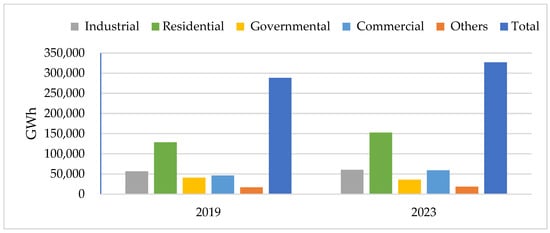
Figure 1.
Energy consumption by sector in Saudi Arabia between 2019 and 2023 [26].
This study explores the critical role of energy efficiency in organizational sustainability, the importance of energy management standards like ISO 50001, and the specific case of SASO’s successful adoption of the ISO 50001 EnMS. In particular, it examines the motivations, challenges, and benefits associated with implementing ISO 50001 at SASO in order to answer the following question: To what extent is implementing ISO 50001 beneficial for a governmental organization, despite its relatively low energy use, and how can that implementation be optimized? In doing so, the study aims to contribute to the body of knowledge in two ways: (a) by demonstrating how governmental organizations can leverage energy management standards to achieve significant energy savings and contribute to broader environmental and economic goals, and (b) by providing actionable insights to help other governmental organizations implement the ISO 50001 standard most effectively.
2. Literature Review
The adoption of energy management standards such as ISO 50001 has gained significant traction as organizations worldwide seek to improve energy efficiency and reduce carbon emissions [28,29,30], and a growing body of research focuses on the standard’s effectiveness in improving energy management practices and contributing to broader environmental sustainability goals [31]. Recent studies have explored various dimensions of ISO 50001 implementation, from its impact on energy efficiency and cost savings to its role in reducing greenhouse gas emissions and fostering organizational innovation [32,33,34], and these are examined in more detail below.
2.1. Global Adoption and Impact of ISO 50001
ISO 50001 provides a structured framework for organizations to systematically improve their energy performance through the development and implementation of energy management policies, objectives, and processes [35,36,37]. Since its introduction in 2011, ISO 50001 has seen widespread adoption across various sectors, with significant uptake in industries characterized by high energy consumption, such as manufacturing, chemical processing, and utilities [31,38,39], and a growing body of literature now documents its positive impact on energy efficiency [14,32,40]. For example, research shows that facilities that have implemented ISO 50001 report a higher average annual energy performance improvement in comparison to non-certified facilities [18]. These improvements are largely attributed to the standard’s emphasis on continuous monitoring, measurement, and analysis of energy performance, which allows organizations to identify inefficiencies and implement corrective measures effectively. Recent studies have also demonstrated the financial benefits associated with ISO 50001 [37,41,42,43]. For instance, the U.S. Department of Energy’s Better Buildings Initiative highlights that organizations adopting ISO 50001 have achieved substantial cost savings, with some reporting reductions in energy costs even within the first few years of implementation [44,45]. These savings are particularly significant in energy-intensive industries, where even small improvements in energy efficiency can result in considerable cost reductions. However, the impact of ISO 50001 implementation in government buildings is not yet well-understood, with few case studies published (e.g., [46,47,48]) and limited critical analysis and evaluation (See Section 2.5).
2.2. Benefits of ISO 50001 Implementation
One significant area of research has examined the quantitative impacts of ISO 50001 on energy consumption and emissions reductions. A study published in the journal Sustainability analyzed data from over 28 EU municipalities and found that ISO 50001-certified facilities achieved a significant reduction in energy consumption within the first three years of certification. These reductions were accompanied by a corresponding decrease in CO2 emissions, highlighting the standard’s potential to contribute to climate change mitigation efforts on a global scale [49]. In addition to energy savings, researchers have investigated the financial benefits associated with ISO 50001 certification. A comprehensive analysis conducted by the International Journal of Production Economics found that organizations implementing ISO 50001 reported average cost savings in their energy expenditures [35]. The study also noted that the payback period for ISO 50001 certification typically ranged from 1 to 3 years, making it a financially viable investment for a variety of organizations, not just those in energy-intensive sectors [35].
Another important line of research has focused on the benefits of integrating ISO 50001 with other management systems, such as ISO 14001 (environmental management) [50,51], ISO 9001 [52] (quality management), and ISO 45001 [53] (occupational health and safety management) [54,55,56]. This integrated approach allows organizations to streamline their management processes, reduce redundancies, and enhance overall sustainability performance. For example, a study conducted in the European Union found that organizations that integrated ISO 50001 with ISO 14001 achieved greater improvements in energy efficiency and environmental performance compared to those that implemented ISO 50001 in isolation [57]. This research emphasizes the synergistic benefits of an integrated management approach, where the alignment of energy, environmental, and quality objectives leads to more comprehensive and sustainable operational improvements [58].
2.3. Using Digital Technology to Enhance ISO 50001 Implementation
Another emerging trend is the use of digital tools and advanced data analytics to enhance the effectiveness of ISO 50001 [59,60]. Recent papers have explored the application of predictive analytics [61,62], Internet of Things (IoT) technologies [59], and artificial intelligence (AI) in energy management [61]. These technologies enable real-time monitoring of energy consumption, predictive maintenance of energy-intensive equipment, and more accurate forecasting of energy needs, which can lead to further improvements in energy efficiency. Analysis has also demonstrated that integrating IoT sensors with an ISO 50001-compliant EnMS resulted in a reduction in energy consumption, highlighting the potential of these technologies to enhance the standard’s impact [63]. Recent work published in IEEE Transactions on Industrial Informatics explored the application of IoT technologies and AI in EnMS [64]. The study demonstrated how IoT-enabled sensors, coupled with AI-driven predictive analytics, can provide real-time insights into energy consumption patterns, identify inefficiencies, and optimize energy usage across facilities. For example, a case study of a manufacturing plant in Japan showed that the integration of IoT with ISO 50001 led to a reduction in energy consumption by enabling more precise control over heating, ventilation, and air conditioning (HVAC) systems, as well as lighting and machinery operations [64].
Overall, the literature on ISO 50001 underscores its effectiveness as a comprehensive framework for improving energy efficiency and contributing to organizational sustainability. Recent trends in the implementation of ISO 50001, such as the integration with other management systems and the use of digital technologies, have further enhanced its impact. However, challenges remain, particularly for small- and medium-sized enterprises (SMEs), which may require additional support to overcome the barriers to adoption.
2.4. Challenges and Barriers to ISO 50001 Adoption
Despite its proven benefits, the implementation of ISO 50001 is not without challenges. SMEs often face barriers such as the initial cost of certification, the need for specialized expertise, and difficulties in quantifying the financial benefits of energy management [65,66]. A recent survey of SMEs found that, while many recognize the potential benefits of ISO 50001, the cost and complexity of implementation deter widespread adoption [66]. One of the key barriers to the implementation of an EnMS is the initial cost involved. This requires implementing measures to enhance existing systems, as well as investing in human capital through training and awareness raising, and recent research suggests that accurately estimating the cost savings that can be achieved in non-industrial sectors can be difficult. For example, in the retail sector, Groupe Liberté (Argentina) achieved financial savings of USD 806,000 as a result of their implementation in 2020, but that was 77% less than the savings initially estimated [67]. And, in the educational and research institutes sector, Tyndall National Institute (Ireland) outperformed the LG Research Institute (Korea), achieving 24% higher financial savings, despite beginning its EnMS implementation later than LG and spending considerably less money [68,69]. To address these challenges, some organizations are adopting phased approaches, beginning with energy audits and basic energy management practices before pursuing full certification, and government incentives and support programs can also play a key role in mitigating some of the financial uncertainty.
2.5. Support for ISO 50001 Implementation
In regions where energy efficiency is a national priority, such as the European Union and the United States, financial incentives, technical assistance, and public recognition have been instrumental in driving the uptake of ISO 50001 [31]. As noted above, in the KSA, the implementation of ISO 50001 at SASO has been supported by national initiatives aligned with Saudi Vision 2030, which aims to enhance energy efficiency and reduce carbon emissions across the Kingdom. This movement is also supported at an inter-governmental level by a number of organizations, notably the Clean Energy Ministerial (CEM), which actively supports the implementation of the ISO standards. The CEM is a high-level global forum that aims to promote policies and programs that promote clean energy technology and its adoption around the world. The 29 member states are represented by energy ministers who discuss ways to cooperate in promoting clean energy solutions, climate challenges, improving energy efficiency, and promoting sustainable development.
The CEM works on several initiatives, including the Energy Management Leadership Awards Program, which aims to “recognize leading organizations for their energy management achievements and raise the profile of the ISO 50001 EnMS as a proven, broadly applicable solution to global energy, climate, and decarbonization challenges” [70]. Entities around the world that have obtained ISO 50001 accreditation are invited to submit case studies that provide replicable descriptions of their implementation process, detailing the resulting business benefits and offering practical advice to help others adopt similar approaches successfully. Case studies are assessed by an independent committee that includes energy experts from around the world and are published on the CEM website. SASO participated in the 2024 edition as one of the few governmental entities and was awarded the Global Energy Management Leadership Insight Award [71].
3. ISO 50001 Implementation at SASO: Strategy and Methodology
The primary objectives of implementing the ISO 50001 EnMS are to save organizations money by increasing energy efficiency, reduce greenhouse gas (GHG) emissions, and enhance public relations by demonstrating tangible efforts in energy management [72]. The ISO provides clear guidance to support the implementation of its standards, and SASO rigorously followed the ISO 50001 standard guidelines to enhance the energy efficiency within the organization. The core methodology is illustrated in the ISO 50001 flowchart (See Figure 2), and this process formed the basis of the implementation at SASO.
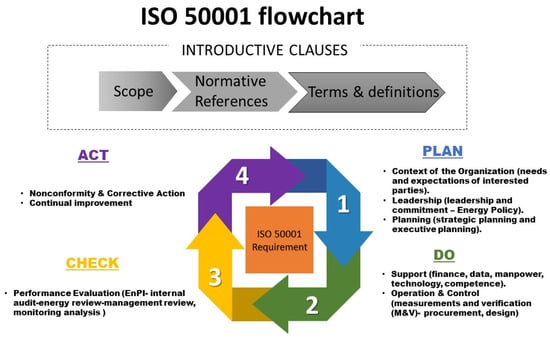
Figure 2.
ISO 50001 flowchart showing steps of Plan, Do, Check, Act methodology [67].
The dataset used in this study is derived from data documented by SASO Energy Management Team members during the period from 1 January 2020 to the end of 2023. The team includes representatives from Facilities Management (responsible for the operation and maintenance procedures of buildings and equipment), the Procurement Department, the General Services Department (responsible for SASO vehicle fuel), the Internal and External Communication Department, the Training Department (responsible for the evaluation and identification of competencies) and the Energy Efficiency Initiatives Department. The latter is responsible for leading the Energy Management Team, developing strategic energy consumption plans, updating the baseline, and setting and monitoring energy performance indicators. The specific responsibilities assigned to team members are detailed in Section 3.5.
3.1. Assessing the Implementation Sites
One of the first tasks was to assess the current status of the implementation sites from an energy management perspective. At SASO, these are exclusively government buildings that provide administrative services to all citizens, spread across three cities: Riyadh, Jeddah, and Dammam. Figure 3 shows the scope of SASO’s estate, which includes 14 buildings that are monitored daily for operations and maintenance by the facilities department. These buildings benefited from retrofit works carried out by Tarshid (prior to the reporting period in this study), and this included the installation of building management systems that can report any sudden increases in energy consumption.
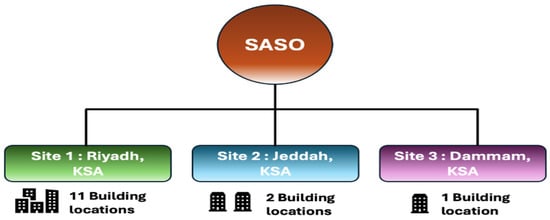
Figure 3.
SASO site/building locations across KSA.
Table 1 displays the details of the total internal areas of the buildings and the number of end users. The main building in Riyadh (Site No. 1) consumes about 86% of the total annual electricity consumption across the sites, the Jeddah building consumes about 8% (Site No. 2), and the Dammam building consumes about 6% (Site No. 3).

Table 1.
Details of SASO’s buildings.
3.2. Establishing the Energy Baseline (EnBI)
Baseline Period (EnBI): Another early step was to establish an energy baseline to facilitate the monitoring and checking processes required to comply with the Plan, Do, Check, Act methodology. The baseline is defined as a quantitative reference that provides a basis for comparing energy performance and is usually calculated before and after the retrofit isolation period, and the baseline is set in the reporting period. In this study, the baseline period was determined for all sites in 2019, which was the period after the building retrofit works carried out by Tarshid. Figure 4 shows the baseline period and the electricity savings recorded in the following four years.
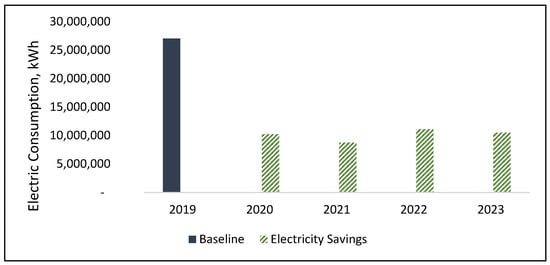
Figure 4.
Electricity savings from baseline year 2019 to 2023.
The baseline is monitored annually by monitoring energy performance during the year and recording all variables related to the increase in energy consumption inside buildings, such as operation hours of cooling systems, outdoor temperatures (CDD), and number of end users. The baseline is updated, if necessary, through statistical regression analysis to measure the strength of the impact of these factors.
3.3. Identifying the Factors Affecting Energy Consumption (Strong Independent Variables)
The first step toward improving and enhancing energy performance and management requires a predictive study of a building’s energy consumption. Predicting energy consumption helps energy managers evaluate and optimize energy control and enhance building performance. Furthermore, predictions can be used to identify risks, enabling timely control measures when needed. In this study, we used Energy Modeling Simulations through TRNSYS 18 software, analysis of historical data, and statistical analysis to increase the accuracy of our predictive analysis.
A key stage in this process at SASO was to identify the factor(s) that increase the energy consumption inside SASO buildings. In this case, outdoor temperatures (CDD) (R2 = 0.92) were identified as the key factor, as the set of the other factors, such as no. of end users, did not exceed (R2 = 0.42); so, for this reason, they were neglected (See Figure 5).
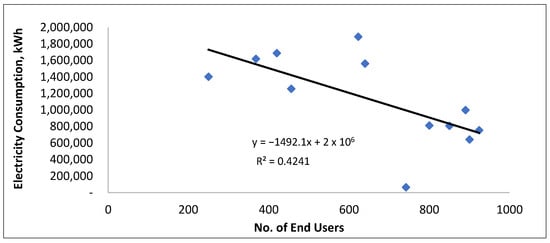
Figure 5.
Impact of end users on energy consumption inside SASO buildings.
3.3.1. Outdoor Conditions
Figure 6 shows the monthly cooling rate distribution across the SASO sites. As this makes clear, the demand for cooling increases significantly during the summer season, which begins in June and continues until the end of October. This rise in temperature is considered the biggest challenge in reducing energy consumption at SASO, requiring high precision in the operation of HVAC systems inside buildings and the exploitation of every opportunity to achieve annual savings.
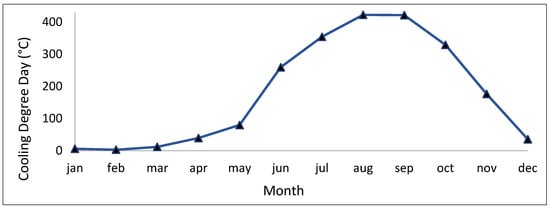
Figure 6.
Cooling degree day (CDD) normalization in KSA.
3.3.2. Calculating the Impact of CDD on Cooling Systems and Refrigerants
The energy consumption of cooling and air conditioning systems, including, but not limited to, chillers, boilers, cooling towers, and air handling units (AHUs), is heavily influenced by outdoor conditions. Cooling systems operate across all the sites (Sites 1, 2, and 3) covering an area exceeding 98,205 square meters (1.05 million square feet), and water-cooled refrigerant uses approximately 70% of the total energy consumption. This consumption rate was calculated through field monitoring of energy consumption and comparison with simulation results to improve the accuracy and quality of results and forecasts. Operating hours were calculated in the simulation program for 10 h per week for 52 weeks (a full working year) and compared to previous historical readings. Some factors that play a role in the increase in consumption were taken into account, such as rising temperatures (year after year) and increasing the number of working hours at certain times of the year (See Figure 7). This analysis underlined the need for careful preparation, seasonal action plans, and effective monitoring during the summer to avoid the risks of sudden increases in consumption, such as the failure of cooling systems, chillers, and their water pumps due to operating at maximum load for extended periods, and the additional costs involved.
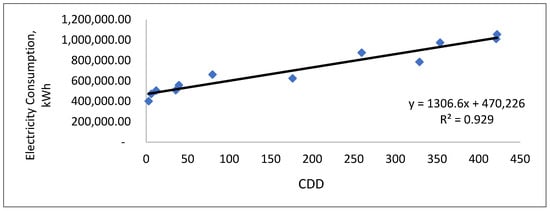
Figure 7.
The impact of outdoor conditions on energy consumption at SASO.
3.4. Data Collection and Monitoring Procedure
Electricity meters inside the buildings are monitored daily and data are collected and documented by a member of the Facilities Management team. This involves taking a picture of the meter readings at different times during official working hours, focusing on the peak demand period at 1 pm to determine the maximum load that the building reaches to inform improvement plans. The data are sent to the team leader to be compared with the monthly electricity bill and calculate the error and relative error in measurement between the collected data and the bill. If the relative error in measurement increases by more than 5%, the meters are checked to ensure they are in good working order. If there is a problem in recording the readings, the condition of the meter is reviewed, to ensure that it has been properly calibrated, and measurement tests are conducted outside working hours and compared with the simulation results to improve the accuracy and quality of the results and measurement. This process is illustrated in Figure 8.
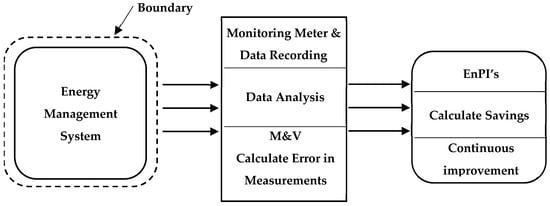
Figure 8.
Data collection procedure employed at SASO.
3.5. Energy Management System (EnMS) Team Responsibilities
The operational responsibilities of the EnMS team include a range of tasks aimed at the effective implementation of the ISO 50001 standard at SASO and the development of methodologies to monitor and improve energy performance. Table 2 shows the responsibilities of the EnMS team members in line with the ISO 50001 EnMS standard, and the additional procedures they developed outside the ISO 50001 framework to enhance the overall quality of the implementation.

Table 2.
Activities and responsibilities of the energy management system team.
3.6. Operational Planning and Control
The team then established, implemented, and now monitor and maintain, processes related to reducing SASO’s significant energy consumption as required by the ISO 50001 EnMS. A number of key actions were identified to address the risks, opportunities, and energy targets, and these were planned and implemented across the three SASO sites. These targeted buildings, equipment (including vehicles), and employees (see Table 3). The final task in the list was the achievement of ISO 50001 accreditation, and this was successfully accomplished in February 2024. The impact of these measures on SASO’s energy consumption and costs is quantified, analyzed, and discussed in the next section.

Table 3.
Measures to enhance energy efficiency aligned with the ISO 50001 EnMS.
4. Results
The initial implementation of ISO 50001 resulted in substantial reductions in both energy consumption and costs. As explained above, the year 2019 was selected as the baseline for this study, with a total electricity consumption of 27.02 GWh per year. Following the implementation of the ISO 50001 standard, overall electricity consumption decreased from 27.02 GWh to 16.5 GWh per year. Figure 9A,B present the total electricity consumption as well as a breakdown of electricity usage by site for the period from 2020 to 2023, and shows that the sites in Dammam, Jeddah, and Riyadh have reduced their electricity consumption per capita per year to 18.90, 15.38, and 15.21 GWh/Capita/Y, respectively. In addition to these reductions, significant cost savings were achieved. Figure 9C,D illustrate the electricity cost savings and the energy consumption in barrels of oil equivalent per year (BOE/Y).
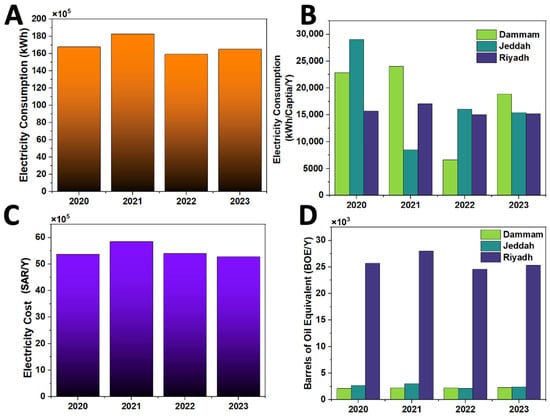
Figure 9.
Electricity consumption in SASO buildings: (A) total consumption, (B) consumption by site, (C) annual electricity cost, and (D) energy usage in BOE per year [Baseline: 2019].
As Figure 9 demonstrates, despite the overall reductions, an increase in electricity cost and consumption was observed in 2021. This was identified and attributed to non-compliance with standard operating procedures and highlighted critical areas for improvement. In response, comprehensive training programs for employees and personnel were instituted to reinforce adherence to standard operating procedures. This corrective action effectively mitigated the previous year’s shortcomings, leading to resumed progress in energy savings and cost reductions in subsequent years. In addition, continuous monitoring and analysis were performed to identify further opportunities for optimization and to ensure sustained compliance with energy management practices. Table 4 shows the reductions in electricity consumption from 2019 to 2023 and the cost savings this represented each year, with the effects of the remedial activities undertaken in 2022 resulting in a 41% reduction in consumption overall.

Table 4.
Overall reduction electricity consumption from 2019 to 2023 with associated cost savings.
The baseline year here, 2018, was the main focus of Tarshids’s efforts, representing 30% of its initiatives. It likely served as the foundation for the 2019 benchmarks, based on the savings achieved. However, from 2019 to 2023, continued savings resulted from the team’s proactive measures, including the impact of COVID-19 in 2020 (See Figure 10).
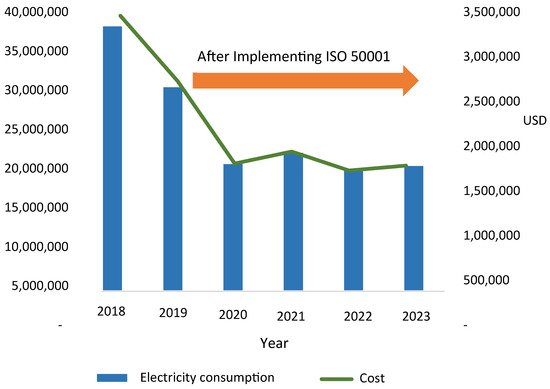
Figure 10.
Reductions in energy consumption at SASO after ISO 50001 implementation [Baseline: 2019].
The charts provided in Figure 11 show how these reductions were achieved. Figure 11A illustrates the changes in electricity consumption as the ISO 50001 standard protocols were implemented in comparison with the baseline. In 2020, a 38% reduction was reported; however, as noted above, these savings were reduced to 32% in 2021 due to an increase in energy demand due to non-compliance with standard operating procedures. Once these issues had been addressed, further significant reductions of 41% in 2022 and 39% in 2023 were achieved.
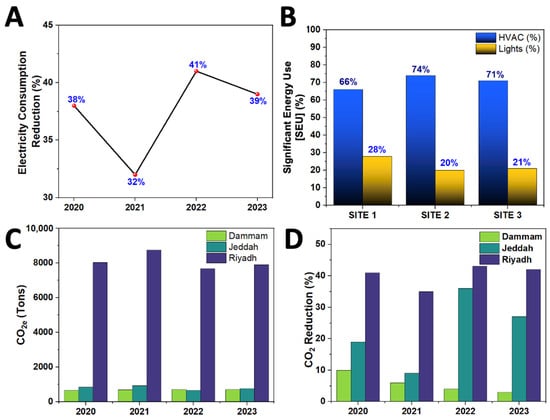
Figure 11.
(A) Electricity consumption reduction, (B) reduction in energy usage for lighting and HVAC, (C) CO2 emissions, (D) CO2 emissions reduction.
Figure 11B highlights the significant energy usage improvement in lighting and HVAC systems across all three SASO sites; this was achieved through the implementation of best practices and energy-efficient technologies in building operations, including the integration of building management systems (BMS) and the replacement of existing lighting with higher efficiency units. Since 2020, the EnMS team has enhanced building operations, leading to a 39% reduction in electricity consumption and total savings of approximately 40.6 million kWh since 2019.
Figure 9D and Figure 11C present the equivalent CO2 emissions and percent reductions in emissions on a year-by-year basis in comparison with the baseline year (2019). As Figure 11C shows, SASO reported total emissions of 9519 tons of CO2e for the year 2023, representing a total reduction of 22,208 tons, or 38%, from the baseline year. Figure 11D illustrates the percentage reduction in CO2 emissions for each site over the study period. From 2020 to 2023, a steady overall decrease in emissions can be observed in Riyadh and Jeddah; however, in Dammam, an increase in the total energy consumption due to operational expansion has led to an increase in emissions. Nonetheless, overall, the emissions of all three sites combined have declined. Table 5 summarizes the combined year-by-year reductions in CO2 emissions for all the sites.

Table 5.
Combined CO2 emissions for all three SASO sites.
Analysis of the variation in the energy use index (EUI) and energy cost index (ECI) over the years revealed important trends. As shown in Figure 12A, the energy use index, which measures the energy consumption per unit area, showed fluctuations correlating with changes in cooling degree days (CDD). CDD is a weather metric used to estimate the demand for energy needed to cool a building. It is calculated by subtracting a base temperature, in this case, 24 °C, from the day’s average temperature. If the average temperature is higher than the base temperature, the difference is summed to determine the CDD for that day. By aggregating these values over a given period, the cooling requirements and, consequently, the energy consumption related to cooling systems, were assessed. In years with higher CDD values, the EUI tended to rise due to increased cooling demands. Conversely, years with lower CDD values saw a reduction in the EUI, reflecting lower energy consumption for cooling.
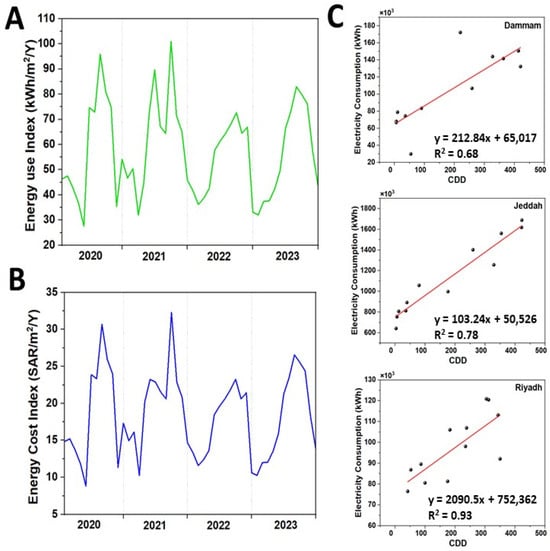
Figure 12.
(A) Energy use index, (B) energy cost index for all SASO buildings combined, (C) regression analysis of electricity consumption against CDD across all three sites.
The energy cost index, which indicates the cost of energy consumption relative to a baseline year, also displayed notable variation over the years (See Figure 12B). Changes in energy prices, improvements in energy efficiency, and variations in CDD contributed to this index’s fluctuations. For instance, in years when energy prices spiked, the ECI increased, even if the energy consumption remained constant or decreased. Conversely, enhancements in energy efficiency measures could lead to a lower ECI, despite high energy consumption.
Several variables were monitored during the data collection and analysis process. These revealed that outdoor conditions, specifically CDD, play a major role in increasing energy consumption, especially during the summer period from June to September. In addition, other variables, such as the number of operating hours for buildings and equipment and the number of end users of the buildings, were also considered. However, these variables did not have a strong effect (R2 = 0.40) compared to outdoor conditions and were, therefore, excluded from the variables affecting the increase in consumption. Furthermore, to establish a robust energy baseline, a comprehensive statistical regression analysis was conducted, focusing on the relationship between energy consumption and CDD at a baseline temperature of 24 °C. This approach allowed for the quantification of the extent to which variations in temperature influence energy usage, particularly during periods requiring cooling. The results of the regression analysis demonstrated a significant correlation between CDD and energy consumption. Higher CDD values corresponded with increased energy use, underscoring the sensitivity of energy consumption to temperature changes above the 24 °C threshold. This strong relationship validates the use of CDD as a predictor for energy consumption in cooling applications. The developed energy baseline served as a reliable tool for forecasting energy needs, optimizing operational efficiency, and implementing energy-saving strategies based on anticipated temperature fluctuations.
4.1. Energy Review Analysis
4.1.1. Savings and Energy Performance Indicators
Electrical energy consumption for HVAC systems, pumps, motors, and cooling towers was measured using regularly calibrated devices provided by a third party. The barrel of oil equivalent index (BOE/kWh/y), CO2 emissions index (ton/y), carbon footprint (ton/y), energy use index (EUI) (kWh/m2/y), and electricity consumption per person index (kWh/P/y) were chosen as the key performance indicators. Energy performance indicator improvement (EnPI) was calculated using Equation (1).
As explained previously, data are collected on a monthly basis by monitoring and recording the electricity consumption readings inside buildings and comparing them with the monthly electricity bills from the energy provider in order to increase the accuracy and quality of the data. During this process, the error and relative error of the meter reading are calculated compared to the electricity bill; electricity bill readings are used because they reflect the true amount of payment and costs. Examples of the data used to check the accuracy and quality of the data across the three sites are shown below (See Table 6) along with the calculations used (See Equations (2) and (3)).

Table 6.
Examples of the data used to check the accuracy of the meter readings.
The consumption per person inside a building was calculated by dividing the total energy used inside the building by the number of persons using energy (See Equation (4)). In the case of several different buildings, the consumption across all the buildings was assessed and the average consumption was taken. There is another, alternative practice based on adding the consumption for all buildings and using the highest consumption value. The number of electrical appliances inside the buildings is considered; for example, the consumption per person in a laboratory building is not the same as the individual consumption in an administrative building.
The electricity cost was calculated using Equation (5).
Elec. cost = Amount of kWh × Elec. Tariff (0.32) SAR/kWh
In Saudi Arabia, there is a fixed coefficient for converting electrical energy into barrels of oil equivalent and all parties must use it. Another practice is to convert electrical energy into thermal energy and calculate the consumption of barrels of oil equivalent in gigajoules and then divide it into liters of oil equivalent, where one barrel equals 160 L [73].
The energy use index (EUI) is defined as the total electrical energy consumption inside the building divided by the gross area. Significant energy use was calculated using an energy simulation model created using TRNSYS 18 (Transient System Simulation Tool) software, so that the HVAC consumption was separated from lighting consumption. There is another practice which is performed by calculating the chiller, motor, AHU, and pump consumption, dividing it by the total monthly electricity bill, calculating the number of lights inside the buildings, and multiplying it by their power input and operating hours.
The relative error between the simulation program and the other practice was 1.5%. In Saudi Arabia, there is a fixed coefficient for converting electrical energy into a ton of CO2 and all parties must use it (See Equation (6)).
CO2 = kWh × Convert Factor
4.1.2. Developing the Energy Performance Dashboard
A key element in the implementation of ISO 50001 at SASO was the development of an interactive performance dashboard, which was deployed from the beginning of 2021. This optimizes and streamlines the management of energy consumption across the organization’s geographically dispersed buildings and provides a comprehensive suite of performance indicators, which can be categorized as follows:
- Economic Indicators: energy cost index (ECI—S.R/m2/y), electricity cost (S. R/kWh/y), and fuel cost index (S. R/liter/y).
- Energy performance indicators: barrel equivalent oil consumption index (Boe/kWh/y), CO2 emissions index (ton/y), carbon footprint (ton/y), energy use index (EUI—kWh/m2/y), and electricity consumption per person index (kWh/P/y).
- Indicative performance indicators: reactive power, peak demand, power factor, and load factor.
This dynamic tool streamlines the process of monitoring diverse sites and equips stakeholders with actionable insights to drive sustainable energy management practices. Its sophisticated predictive analytics empower the EnMS team to anticipate energy waste or conservation opportunities with a high degree of accuracy, and, by providing continuous monitoring and analysis, it facilitates the identification of points of efficiency and enables proactive interventions to optimize energy usage (See Figure 13). With its tailored approach to each building’s unique characteristics and usage patterns across SASO’s sites, the dashboard offers a nuanced understanding of EnPIs at every level, enabling decision-makers to gain real-time insight into consumption trends which can then be used to inform targeted strategies for conservation and waste reduction.
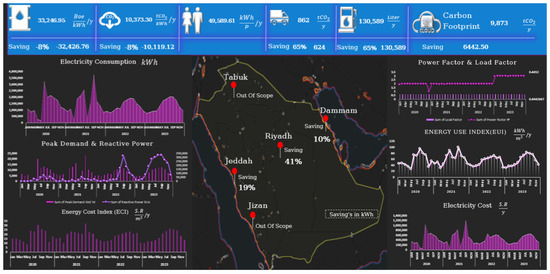
Figure 13.
Interactive energy performance dashboard for all sites and buildings.
4.2. Cost–Benefit Analysis
From an economic perspective, implementing an EnMS is intended to secure financial savings, vital for an organization, and realize a return on investment in a relatively short time. The initial cost of implementing the EnMS at SASO in 2019 was USD 12,267, which covered only the certification body fees for auditing and issuing the ISO 50001 certificate. Since its adoption, the system has generated an estimated return of USD 3.6 million over four years. This compares favorably with other organizations in the governmental or educational sectors (See Figure 14). For instance, Abu Dhabi Distribution (UAE), another government entity, incurred implementation costs which were approximately 15 times higher than SASO, at USD 180,058, but achieved net financial savings of around USD 8,008,974, less than 3 times higher than SASO’s [74]. None of the other comparator organizations achieved savings above USD 1 million, which is roughly 92% lower than SASO. Overall, then, SASO’s implementation seems to have been effective; however, it is also important to consider the payback period.
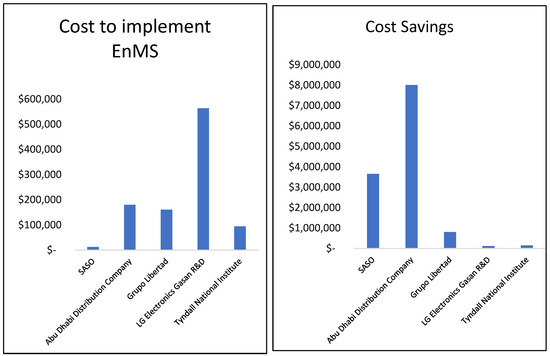
Figure 14.
Comparison of ISO 50001 implementation costs and savings with other organizations.
Over time, the economic benefits of implementing energy-saving measures can match the initial investment, and this period should be considered the expected payback period. However, if the investment’s payback period is longer than the expected lifespan or operational time of the EnMS, it is considered economically unviable [75]. The payback period for SASO’s implementation was calculated using Equation (7).
As shown in Table 7, SASO has the shortest payback period among these organizations. However, it is interesting to note that, even with the limited cost savings achieved, both Libertad and Tyndall had payback periods of less than one year, supporting the idea that investing in such systems is a viable way to reduce operational costs and promote sustainability, even for institutions outside the industrial sector.

Table 7.
Comparative payback periods across various countries.
5. Discussion and Future Directions
SASO takes pride in being the first government sector in Saudi Arabia to achieve ISO 50001 accreditation, reflecting its commitment to energy management excellence. This has been achieved by the rigorous application of the ISO 50001 principles of Plan, Do, Check, and Act to meet EnMS requirements with respect to operational planning and control. Processes related to significant energy usage have been established and implemented and are now carefully controlled and maintained to address risks, seize opportunities, and achieve energy objectives. The EnMS team, responsible for ISO 50001 implementation, monitors energy performance regularly and monthly meetings track progress, with monthly reports submitted to the SASO Governor. Indeed, senior management has played a pivotal role in supporting EnMS implementation, providing resources and financial support, and ensuring that departments across the organization play their part. The validity of the ISO 50001 Plan, Do, Check, Act methodology as a model for successful implementation is therefore endorsed by SASO’s experience.
5.1. Benefits of ISO 50001 Implementation at SASO
The benefits of implementation in terms of environmental, economic, and organizational improvements are clear. Through a systematic and data-driven approach, SASO has achieved a 39% reduction in electricity consumption and a corresponding 38% decrease in CO2 emissions compared to the baseline year of 2019. These have resulted in substantial cost savings of approximately USD 3.6 million, demonstrating the financial viability of adopting ISO 50001 as a core component of energy management strategies. Organizational benefits include increased energy awareness among staff, enhanced training provision, and an emphasis on adherence to standard practices, with EnMS team members holding certifications in energy management, and EnMS documentation standardized across all sites. Criteria have also been established to assess energy use when procuring products, equipment, and services, and a customized model for energy purchases now ensures devices are acquired only after thorough analysis of operation hours and power input, particularly in laboratory sectors, thereby enhancing consumption control and monitoring.
5.2. Use of Digital Technology to Enhance Implementation
The adoption of advanced technologies, such as energy simulation models and interactive performance dashboards, has significantly enhanced SASO’s ability to monitor, analyze, and optimize energy consumption across its facilities. These tools enable the precise tracking of energy use, providing detailed insights into patterns, inefficiencies, and opportunities for improvement. By integrating simulation models, the organization can forecast energy demands and evaluate the potential impact of various energy-saving measures before implementation. Furthermore, the adoption of dashboards has improved energy awareness among SASO’s user groups by presenting complex data in a clear and visually engaging manner. This empowers stakeholders to make informed decisions based on accurate and timely information, ultimately contributing to the achievement of energy efficiency goals. By fostering a culture of data-driven decision-making and accountability, the dashboard has catalyzed a paradigm shift toward sustainable energy practices, ultimately enhancing operational efficiency and environmental stewardship across the entire portfolio of buildings and sites. Additionally, the use of such technologies fosters a culture of accountability and continuous improvement, ensuring that energy performance remains a priority across the organization.
5.3. Challenges and Barriers to ISO 50001 Adoption at SASO
Although the introduction of the EnMS at SASO has been a success, it was not without its challenges. However, through careful monitoring, a willingness to innovate, and close collaboration between the EnMS teams, senior management, and other departments, solutions have been identified which have enhanced overall effectiveness.
A significant challenge in the early stages was non-compliance with certain operational instructions provided by the EnMS team, particularly by employees who accessed buildings out-of-hours. This hindered the uniform implementation of energy-saving measures and created inefficiencies in achieving organizational energy goals. To address this, SASO launched the ‘Marhaba’ application, with the aim of streamlining the process for entering the premises outside official working hours. Employees are required to secure approval from their sector head, and the app ensures that all such requests are documented, organized, and decided through seamless coordination with the Human Resources department. By implementing ‘Marhaba’, SASO has not only improved the management of out-of-hours access, enhancing oversight and compliance with established protocols, but it also ensured that the EnMS team is kept informed, allowing them to plan and monitor energy usage effectively. This solution has, therefore, fostered better accountability, minimized unauthorized access, and supported the broader goals of the EnMS.
The distance between the sites also created difficulties in maintaining control over energy use. This issue was resolved by integrating all the branches into a unified building management system (BMS), managed by the Facilities Management department (part of the EnMS team). This centralized system ensures that the team has full control over building operations across all locations, regardless of their geographical location. By consolidating control in this way, the team can swiftly identify issues, enforce energy-saving measures, and maintain consistency in energy management practices across all facilities. The use of new devices and electrical systems within the organization without first evaluating their efficiency was identified as a risk which could lead to higher energy use and negatively affect the overall consumption results. As noted above, this led to the establishment of a formal process which requires all purchases of electrical products to be approved by the EnMS team in advance to ensure that any new device has the lowest possible consumption rate while maintaining high quality standards.
While the major issues have been successfully addressed, minor issues around non-compliance, such as employees failing to turn off computers, copiers, and printers after the workday, persist. Overcoming this challenge requires a culture change across the organization, so the focus is now on increasing awareness campaigns, holding workshops, and offering training to improve employees’ understanding of energy-saving practices and their role in cutting organization expenses. While these have been found to have a direct positive effect on the employees, supervisors have also been assigned to monitor the buildings and confirm that all devices are switched off each day.
5.4. Future Developments for SASO
SASO successfully passed Stage 1 and 2 audits for ISO 50001 certification in February 2024, with zero non-conformities. However, the organization is committed to further advancing its energy management practices, with plans to increase its reduction in CO2 emissions to approximately 60% by 2030. In order to achieve this, several strategic initiatives are planned. These include linking energy targets with SASO’s main performance indicators to ensure alignment with overall organizational goals and enhancing awareness beyond email communication by conducting workshops and fostering employee-driven initiatives. The integration of ISO 50001 with other management systems, such as ISO 14001 and ISO 41001, is also planned to optimize organizational processes and performance. Preparations for the extension of the EnMS to cover the sites at Damman and Jizan are also underway, and comprehensive training courses for team members will be implemented well in advance to ensure readiness and enhance compliance. SASO will also draw upon international experiences while tailoring strategies to its specific operational context, with the goal of sharing successful practices with other government sectors. More broadly, the organization aims to share its experiences and best practices with other sectors within Saudi Arabia, contributing to a broader culture of sustainability.
5.5. Future Directions for ISO 50001 Research
In terms of future research directions, ISO 50001 offers a framework for organizations to enhance energy efficiency internally by establishing policies and objectives. It also facilitates continuous improvement in energy management by setting targets and measuring results. However, ISO 50001 certification is optional, and the decision to adopt or decertify from this standard is influenced by various factors. Organizations may pursue it for internal benefits or to demonstrate compliance to external parties, but decision-making processes vary across industries, countries, and regions. In addition, unlike some other standards, ISO 50001 impacts not only the organization itself but also third parties, such as governments aiming to meet emissions targets, and stakeholders advocating for sustainable practices. Developing a broader understanding of the motivations for certification and the potential benefits is crucial for both organizations and the ISO, but long-term data collection is essential to assess trends accurately. Future research should also explore the differences between adopters and non-adopters and analyze the diffusion of ISO 50001 across various sectors and regions. Understanding the characteristics of adopters (innovators, early adopters, and laggards) will aid in predicting future adoption behaviors, benefiting not only managers but also accreditation and certification bodies and consultants involved in ISO 50001 implementation.
5.6. Future Stratigic Plan
Through successful implementation of the ISO 50001 standard, SASO has succeeded in gradually reducing CO2 emissions by 38% compared to the baseline in 2019. By 2030, SASO aims to reach a reduction rate of approximately 60%, in line with the Kingdom’s initiative to achieve net-zero GHG emissions by 2060. The roadmap in Figure 15 reflects a long-term strategic vision to enhance energy consumption and reduce carbon emissions by 2030, in alignment with national sustainability goals. It highlights major milestones and structured phases to ensure accountability, performance measurement, and continuous improvement. The plan is divided into several phases, the first two of which have already been achieved:
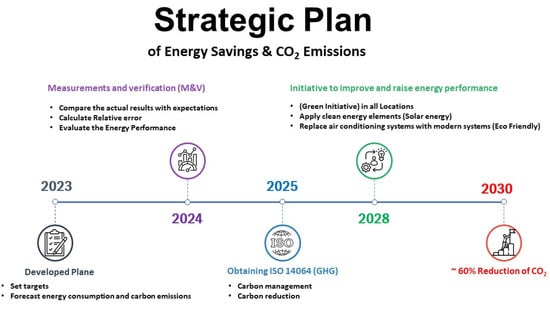
Figure 15.
SASO’s strategic plan for energy savings and CO2 emissions reduction.
- 2023—Developed Plan: The initiative began with the development of a comprehensive energy management and CO2 reduction plan, setting clear objectives and performance indicators.
- 2024—Measurements and Verification (M&V): Implementation of M&V systems to track progress, verify performance, and establish baselines critical for evaluating future outcomes.
- 2025—Obtaining ISO 14064 (GHG): Certification with ISO 14064 to standardize greenhouse gas (GHG) accounting and verification, ensuring transparency and credibility in emissions reporting.
- 2028—Initiative to Improve and Raise Energy Performance: Launch of targeted initiatives to enhance energy efficiency through innovation, technology integration, and stakeholder engagement.
- 2030—~60% Reduction of CO2: The culmination of the strategy, aiming to achieve a substantial reduction in CO2 emissions (~60%) compared to baseline levels, supporting national and global climate goals.
Carbon emissions are reduced by upgrading and replacing existing systems with modern, energy-efficient ones, which helps to reduce consumption and emissions. This is in addition to adding renewable energy sources, activating the organization’s tree-planting initiative, and obtaining ISO 14064 accreditation for carbon reduction and proper carbon management. This strategic plan was developed based on historical readings of previous consumption, the nature of the authority’s buildings’ expansion, and the targeted number of end users. More than 8000 simulation hours were conducted on TRNSYS 18 and Matlab R2025a, and the results are continuously measured and monitored by the Energy Management Team.
6. Conclusions
This study underscores the critical role of ISO 50001 in driving sustainable energy practices and contributing to national and global environmental goals. The implementation of ISO 50001 at SASO has proven to be highly effective in enhancing energy efficiency and reducing carbon emissions, leading to substantial energy savings and a significant reduction in the company’s carbon footprint. The success of SASO’s energy management efforts can be attributed to several key factors, including strong leadership support, robust employee training programs, and the integration of energy management objectives with broader organizational goals, such as those outlined in Saudi Vision 2030.
As global efforts to combat climate change intensify, ISO 50001 is poised to play an increasingly important role in helping organizations meet their sustainability goals. The findings of this study suggest that other organizations, particularly within the public sector, could achieve similar benefits by adopting ISO 50001 and integrating it into their operational frameworks. Additionally, to the best of the authors’ knowledge, this is the first study on the implementation of ISO 50001 in government buildings, such as SASO. The research highlights the importance of continuous improvement and adaptive management in maintaining the momentum of energy efficiency gains and the broader benefits this can bring. The continued alignment of SASO’s energy management initiatives with national sustainability goals positions the organization as a leader in the pursuit of energy efficiency and environmental stewardship, while also enhancing organizational performance.
In exploring SASO’s experiences, this study not only provides a valuable case example of the successful implementation of ISO 50001 but also contributes to the broader literature on energy management systems. Future research should continue to explore strategies for overcoming implementation barriers and examine the long-term impacts of ISO 50001 on organizational performance and sustainability, as well as the potential for integrating this standard with other sustainability frameworks to achieve even greater environmental and economic benefits.
Author Contributions
S.A. (Saleh Alotaibi) initiated the development of this manuscript, conducted the literature review, and took the lead in writing the text; H.A. contributed to data collection and drafting; K.A. provided data analysis and editing; S.A. (Sulaiman Aljarallah) also reviewed and finalized the paper. All authors have read and agreed to the published version of the manuscript.
Funding
This research received no external funding.
Data Availability Statement
The data presented in this study are available on request from the corresponding author.
Acknowledgments
The authors would like to thank the Saudi Standards, Metrology, and Quality Organization (SASO) for their support.
Conflicts of Interest
Author Sulaiman Aljarallah was employed by the Technical and Vocational Training Corporation. The remaining authors declare that the research was conducted in the absence of any commercial or financial relationships that could be construed as a potential conflict of interest.
References
- De la Cruz-Lovera, C.; Perea-Moreno, A.-J.; De la Cruz-Fernández, J.-L.; Alvarez-Bermejo, J.A.; Manzano-Agugliaro, F. Worldwide research on energy efficiency and sustainability in public buildings. Sustainability 2017, 9, 1294. [Google Scholar] [CrossRef]
- Prindle, W.; Finlinson, S. How organizations can drive behavior-based energy efficiency. In Energy, Sustainability and the Environment; Butterworth-Heinemann: Oxford, UK, 2011; pp. 305–335. [Google Scholar]
- Nawaz, W.; Koç, M. Exploring organizational sustainability: Themes, functional areas, and best practices. Sustainability 2019, 11, 4307. [Google Scholar] [CrossRef]
- Alam, M.; Zou, P.X.; Stewart, R.A.; Bertone, E.; Sahin, O.; Buntine, C.; Marshall, C. Government championed strategies to overcome the barriers to public building energy efficiency retrofit projects. Sustain. Cities Soc. 2019, 44, 56–69. [Google Scholar] [CrossRef]
- World Bank. State and Trends of Carbon Pricing 2024; World Bank: Washington, DC, USA, 2024. [Google Scholar]
- ICAP. Emissions Trading Worldwide: Status Report 2024; International Carbon Action Partnership: Berlin, Germany, 2024. [Google Scholar]
- Al-Ghaili, A.M.; Kasim, H.; Al-Hada, N.M.; Jorgensen, B.N.; Othman, M.; Wang, J. Energy management systems and strategies in buildings sector: A scoping review. IEEE Access 2021, 9, 63790–63813. [Google Scholar] [CrossRef]
- Hossain, J.; Kadir, A.F.A.; Hanafi, A.N.; Shareef, H.; Khatib, T.; Baharin, K.A.; Sulaima, M.F. A review on optimal energy management in commercial buildings. Energies 2023, 16, 1609. [Google Scholar] [CrossRef]
- ISO 14001:2015; Introduction to ISO 14001. International Organization for Standardization: Geneva, Switzerland, 2015.
- ISO 14006; Environmental Management Systems—Guidelines for Incorporating Ecodesign. International Organization for Standardization. ISO: Geneva, Switzerland, 2020.
- ISO 14064-1:2018; Greenhouse Gases—Part 1: Specification with Guidance at the Organization Level for Quantification and Reporting of Greenhouse Gas Emissions and Removals. International Organization for Standardization: Geneva, Switzerland, 2018.
- ISO 14031; Environmental Management–Environmental Performance Evaluation–Guidelines. ISO: Geneva, Switzerland, 2013.
- ISO 50001:2018; Energy Management Systems―Requirements with Guidance for Use. ISO: Geneva, Switzerland, 2018.
- McKane, A.; Therkelsen, P.; Scodel, A.; Rao, P.; Aghajanzadeh, A.; Hirzel, S.; Zhang, R.; Prem, R.; Fossa, A.; Lazarevska, A.M.; et al. Predicting the quantifiable impacts of ISO 50001 on climate change mitigation. Energy Policy 2017, 107, 278–288. [Google Scholar] [CrossRef]
- Pandin, M.; Sumaedi, S.; Yaman, A.; Ayundyahrini, M.; Supriatna, N.K.; Hesty, N.W. ISO 50001 based energy management system: A bibliometric perspective. Int. J. Energy Sect. Manag. 2024, 18, 1938–1963. [Google Scholar] [CrossRef]
- Jamieson, M. Future Looks Bright for ISO 50001: Recent Trends, Schneider Electric Blog. 2014. Available online: https://blog.se.com/energy-management-energy-efficiency/2014/06/04/future-looks-bright-iso-50001-recent-trends/ (accessed on 16 April 2025).
- European Environment Agency (EEA). Energy Efficiency. 2024. Available online: https://www.eea.europa.eu/en/topics/in-depth/energy-efficiency (accessed on 16 April 2025).
- Timler, J. Development of an ISO 50001 Energy Management System: Barriers, Drivers, and Enablers in a Local Government of Western Australia. Ph.D. Dissertation, Murdoch University, Perth, Australia, 2021. [Google Scholar]
- Loremia, R.A.; Pardiñan, E.G.; Nilo, A.P., Jr.; Bondad, R.M.; Lantikse, R.G.; Alit, D.G. Energy management practices in state universities and colleges (SUCs): An assessment for an IoT intervention. J. Educ. Hum. Resour. Dev. (JEHRD) 2020, 8, 12–26. [Google Scholar] [CrossRef]
- Savelainen, S. Implementation of SASO Certifications and Import Procedures in Mining Projects in Saudi Arabia. Master’s Thesis, Lappeenranta-Lahti University of Technology, Lappeenranta, Finland, 2020. [Google Scholar]
- Kumar, V.; Albashrawi, S. Quality infrastructure of Saudi Arabia and its importance for vision 2030. Mapan 2022, 37, 97–106. [Google Scholar] [CrossRef]
- Nurunnabi, M. Transformation from an oil-based economy to a knowledge-based economy in Saudi Arabia: The direction of Saudi vision 2030. J. Knowl. Econ. 2017, 8, 536–564. [Google Scholar] [CrossRef]
- Saudi Standards, Metrology and Quality Organization (SASO). Tasks and Objectives. 2025. Available online: https://www.saso.gov.sa/en/about/Pages/responsibilities.aspx (accessed on 16 April 2025).
- Bin Salman Al-Saud, A. A brief on Saudi Arabia’s Energy Efficiency Program (SEEP). Oxford Energy Forum 2014, 96, 4–7. [Google Scholar]
- Amran, Y.M.; Alyousef, R.; Alabduljabbar, H. Renewable and sustainable energy production in Saudi Arabia according to Saudi Vision 2030; Current status and future prospects. J. Clean. Prod. 2020, 247, 119602. [Google Scholar] [CrossRef]
- Saudi Electricity Regulatory Authority. Available online: https://sera.gov.sa/en/ (accessed on 20 January 2025).
- National Energy Services Company (Tarshid). Available online: https://www.tarshid.com.sa/en (accessed on 20 January 2025).
- Hasan, A.S.M.M.; Trianni, A. A review of energy management assessment models for industrial energy efficiency. Energies 2020, 13, 5713. [Google Scholar] [CrossRef]
- Mirza, F.M.; Sinha, A.; Khan, J.R.; Kalugina, O.A.; Zafar, M.W. Impact of energy efficiency on CO2 Emissions: Empirical evidence from developing countries. Gondwana Res. 2022, 106, 64–77. [Google Scholar] [CrossRef]
- Mahi, M.; Ismail, I.; Phoong, S.W.; Isa, C.R. Mapping trends and knowledge structure of energy efficiency research: What we know and where we are going. Environ. Sci. Pollut. Res. 2021, 28, 35327–35345. [Google Scholar] [CrossRef]
- Fuchs, H.; Aghajanzadeh, A.; Therkelsen, P. Identification of drivers, benefits, and challenges of ISO 50001 through case study content analysis. Energy Policy 2020, 142, 111443. [Google Scholar] [CrossRef]
- Yuriev, A.; Boiral, O. Implementing the ISO 50001 system: A critical review. In ISO 9001, ISO 14001, and New Management Standards; Springer: Cham, Switzerland, 2018; pp. 145–175. [Google Scholar]
- Gopalakrishnan, B.; Ramamoorthy, K.; Crowe, E.; Chaudhari, S.; Latif, H. A structured approach for facilitating the implementation of ISO 50001 standard in the manufacturing sector. Sustain. Energy Technol. Assess. 2014, 7, 154–165. [Google Scholar] [CrossRef]
- Mkhaimer, L.G.; Arafeh, M.; Sakhrieh, A.H. Effective implementation of ISO 50001 energy management system: Applying Lean Six Sigma approach. Int. J. Eng. Bus. Manag. 2017, 9, 1847979017698712. [Google Scholar] [CrossRef]
- Zimon, D.; Jurgilewicz, M.; Ruszel, M. Influence of Implementation of the ISO 50001 Requirements on Performance of SSCM. Int. J. Qual. Res. 2021, 15, 713. [Google Scholar] [CrossRef]
- Prasetya, B.; Wahono, D.R.; Dewantoro, A.; Anggundari, W.C.; Yopi. The role of Energy Management System based on ISO 50001 for Energy-Cost Saving and Reduction of CO2-Emission: A review of implementation, benefits, and challenges. IOP Conf. Ser. Earth Environ. Sci. 2021, 926, 012077. [Google Scholar] [CrossRef]
- Baxter, G. An Assessment of the use of the ISO 50001 Certified Energy Management Systems by Airports. Int. J. Environ. Agric. Biotechnol. 2022, 7, 84–98. [Google Scholar] [CrossRef]
- Wulandari, M.; Laskurain, I.; Fa, M.C.; Heras-Saizarbitoria, I. Early adoption of ISO 50001 standard: An empirical study. In Sustainable Operations Management: Advances in Strategy and Methodologyi; Springer: Cham, Switzerland, 2015; pp. 183–202. [Google Scholar]
- Bamber, C.; Elezi, E.; Bamber, D.; Sharp, J.; Guoxi, L. A critical review of ISO management systems certification in the UK agricultural sector. In Proceedings of the 9th Mibes International Conference, Thessaloniki, Greece, 30 May–1 June 2014; Volume 30. [Google Scholar]
- Aghajanzadeh, A.; Therkelsen, P.L.; Rao, P.; McKane, A.T. Global Impact Estimation of ISO 50001 Energy Management System for Industrial and Service Sectors; Lawrence Berkeley National Laboratory: Berkeley, CA, USA, 2016.
- van der Westhuizen, E. Enhancing Energy Policy Adoption Within The South African Financial Services Sector. Stud. Financ. (Financ. Stud.) 2024, 28, 35–56. [Google Scholar]
- Mahmood, N.S.; Ajmi, A.A.; Bin Sarip, S.; Kaidi, H.M.; Jamaludin, K.R.; Talib, H.H.A. Modeling the sustainable integration of quality and energy management in power plants. Sustainability 2022, 14, 2460. [Google Scholar] [CrossRef]
- Durak Uşar, D. Impact of ISO Certifications on Corporate Financial Performance: Evidence from Istanbul Stock Ex-change-Listed Manufacturing Companies. Sustainability 2024, 16, 7021. [Google Scholar] [CrossRef]
- Nadel, S.; Amann, J.; Hayes, S.; Bin, S.; Young, R.; Mackres, E.; Misuriello, H.; Watson, S. An Introduction to US Policies to Improve Building Efficiency; Report Number A134; American Council for an Energy-Efficient Economy: Washington, DC, USA, 2013. [Google Scholar]
- British Standards Institution. City of London Corporation: Energy management with ISO 50001. Public Sector Assurance Case Studies. 2012. Available online: https://publicsectorassurance.org/case-study/public-sector-bodies-implement-iso-50001-to-reduce-energy-costs/ (accessed on 20 January 2025).
- Clean Energy Ministerial. U.S. Air Force Oklahoma City Air Logistics Complex: Global Energy Management Implementation Case Study. Clean Energy Ministerial. 2024. Available online: https://www.cleanenergyministerial.org/content/uploads/2024/09/cem_2024_emla_casestudy_u.s.-air-force-oklahoma-city-air-logistics-complex_.pdf (accessed on 20 January 2025).
- Clean Energy Ministerial. ISO 50001 Energy Management System—Case Study: Roads and Transport Authority (RTA) Dubai. 2024. Available online: https://www.cleanenergyministerial.org/content/uploads/2024/08/cem_2024_emla_casestudy_roads-and-transportation-authority-dubai.pdf (accessed on 20 January 2025).
- Liu, X.; Ge, J.; Feng, W.; Zhou, N. An Overview of the US Better Buildings Initiative as a Model for Other Countries; Lawrence Berkeley National Laboratory: Berkeley, CA, USA, 2017.
- Kaselofsky, J.; Rošā, M.; Jekabsone, A.; Favre, S.; Loustalot, G.; Toma, M.; Marín, J.P.D.; Nicolás, M.M.; Cosenza, E. Getting municipal energy management systems ISO 50001 certified: A study with 28 European municipalities. Sustainability 2021, 13, 3638. [Google Scholar] [CrossRef]
- Psomas, E.L.; Fotopoulos, C.V.; Kafetzopoulos, D.P. Motives, difficulties and benefits in implementing the ISO 14001 Environmental Management System. Manag. Environ. Qual. Int. J. 2011, 22, 50. [Google Scholar] [CrossRef]
- Muktiono, E.; Soediantono, D. Literature Review of ISO 14001 environmental management system benefits and proposed applications in the defense industries. J. Ind. Eng. Manag. Res. 2022, 3, 1–12. [Google Scholar]
- ISO 9001:2015; Quality Management Systems—Requirements. International Organization for Standardization: Geneva, Switzerland, 2015.
- ISO 45001:2018; Occupational Health and Safety Management Systems—Requirements with Guidance for Use. International Organization for Standardization: Geneva, Switzerland, 2018.
- Darabont, D.C.; Antonov, A.E.; Bejinariu, C. Key elements on implementing an occupational health and safety management system using ISO 45001 standard. MATEC Web Conf. 2017, 121, 11007. [Google Scholar] [CrossRef]
- Malinda, A.; Soediantono, D. Benefits of Implementing ISO 45001 Occupational Health and Safety Management Systems and Implementation Suggestion in the Defense Industry: A Literature Review. J. Ind. Eng. Manag. Res. 2022, 3, 35–47. [Google Scholar]
- ISO (International Organization for Standardization). The ISO Survey-2012; ISO Central Secretariat: Geneva, Switzerland, 2013; Available online: http://www.iso.org/iso/home/standards/certification/iso-survey.htm (accessed on 10 November 2024).
- Laskurain, I.; Ibarloza, A.; Larrea, A.; Allur, E. Contribution to energy management of the main standards for environmental management systems: The case of ISO 14001 and EMAS. Energies 2017, 10, 1758. [Google Scholar] [CrossRef]
- Chiu, T.-Y.; Lo, S.-L.; Tsai, Y.-Y. Establishing an integration-energy-practice model for improving energy performance indicators in ISO 50001 energy management systems. Energies 2012, 5, 5324–5339. [Google Scholar] [CrossRef]
- Poveda-Orjuela, P.P.; García-Díaz, J.C.; Pulido-Rojano, A.; Cañón-Zabala, G. ISO 50001: 2018 and its application in a comprehensive management system with an energy-performance focus. Energies 2019, 12, 4700. [Google Scholar] [CrossRef]
- Grimaccia, F.; Niccolai, A.; Mussetta, M.; D’alessandro, G. ISO 50001 data driven methods for energy efficiency analysis of thermal power plants. Appl. Sci. 2023, 13, 1368. [Google Scholar] [CrossRef]
- Moghadasi, M.; Izadyar, N.; Moghadasi, A.; Ghadamian, H. Applying machine learning techniques to implement the technical requirements of energy management systems in accordance with ISO 50001:2018, an industrial case study. Energy Sources Part A Recover. Util. Environ. Eff. 2021, 1–18. [Google Scholar] [CrossRef]
- Jiang, P.; Zheng, J.; Wang, Z.; Qin, Y.; Li, X. Industrial robot energy consumption model identification: A coupling model-driven and data-driven paradigm. Expert Syst. Appl. 2025, 262, 125604. [Google Scholar] [CrossRef]
- Flick, D.; Kuschicke, F.; Schweikert, M.; Thiele, T.; Panten, N.; Thiede, S.; Herrmann, C. Ascertainment of energy consumption information in the age of industrial big data. Procedia CIRP 2018, 72, 202–208. [Google Scholar] [CrossRef]
- Ding, Y.M.; Hong, S.H.; Li, X.H. A demand response energy management scheme for industrial facilities in smart grid. IEEE Trans. Ind. Informatics 2014, 10, 2257–2269. [Google Scholar] [CrossRef]
- Pacheco, L.; Lobo, C.; Maldonado, I. Do ISO certifications enhance internationalization? The case of Portuguese industrial SMEs. Sustainability 2022, 14, 1335. [Google Scholar] [CrossRef]
- Karcher, P.; Jochem, R. Success factors and organizational approaches for the implementation of energy management systems according to ISO 50001. TQM J. 2015, 27, 361–381. [Google Scholar] [CrossRef]
- Clean Energy Ministerial. Grupo Libertad Global Energy Management Implementation Case Study. Available online: https://www.cleanenergyministerial.org/resource/grupo-libertad-global-energy-management-implementation-case-study/ (accessed on 17 April 2025).
- Clean Energy Ministerial. Tyndall National Institute Global Energy Management Implementation Case Study. Available online: https://www.cleanenergyministerial.org/resource/tyndall-global-energy-management-implementation-case-study/ (accessed on 17 April 2025).
- Clean Energy Ministerial. LG Electronics Inc., Gasan R&D Campus Global Energy Management Implementation Case Study. Available online: https://www.cleanenergyministerial.org/resource/lg-electronics-inc-gasan-rd-campus-global-energy-management-implementation-case-study/ (accessed on 17 April 2025).
- Clean Energy Ministerial. Energy Management Leadership Awards. Available online: https://www.cleanenergyministerial.org/initiatives-campaigns/energy-management-leadership-awards/ (accessed on 20 January 2025).
- Clean Energy Ministerial. Winners of 2024 Global Energy Management Leadership Awards Announced. Available online: https://www.cleanenergyministerial.org/winners-of-2024-global-energy-management-leadership-awards-announced/ (accessed on 20 January 2025).
- Eccleston, C.H.; March, F.; Cohen, T. Inside Energy: Developing and Managing an ISO 50001 Energy Management System; CRC Press: Boca Raton, FL, USA, 2011. [Google Scholar]
- The U.S. Energy Information Administration. Energy Conversion Calculators. EIA. Available online: https://www.eia.gov/energyexplained/units-and-calculators/energy-conversion-calculators.php (accessed on 20 January 2025).
- Clean Energy Ministerial. Abu Dhabi Distribution Company Global Energy Management Implementation Case Study. Available online: https://www.cleanenergyministerial.org/resource/abu-dhabi-distribution-company-global-energy-management-implementation-case-study-copy-copy/ (accessed on 17 April 2025).
- Gorshkov, A.S.; Vatin, N.I.; Rymkevich, P.P.; Kydrevich, O.O. Payback period of investments in energy saving. Mag. Civ. Eng. 2018, 2, 65–75. [Google Scholar]
Disclaimer/Publisher’s Note: The statements, opinions and data contained in all publications are solely those of the individual author(s) and contributor(s) and not of MDPI and/or the editor(s). MDPI and/or the editor(s) disclaim responsibility for any injury to people or property resulting from any ideas, methods, instructions or products referred to in the content. |
© 2025 by the authors. Licensee MDPI, Basel, Switzerland. This article is an open access article distributed under the terms and conditions of the Creative Commons Attribution (CC BY) license (https://creativecommons.org/licenses/by/4.0/).